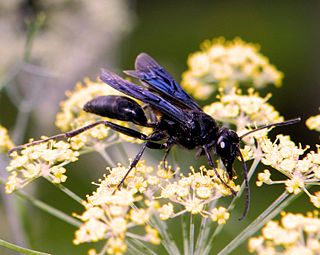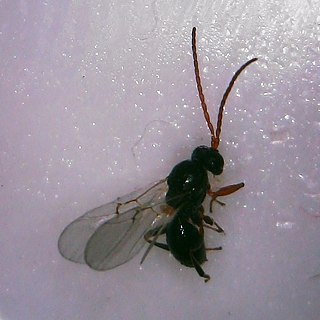
Entomology is the scientific study of insects, a branch of zoology. In the past the term insect was less specific, and historically the definition of entomology would also include the study of animals in other arthropod groups, such as arachnids, myriapods, and crustaceans. This wider meaning may still be encountered in informal use. The field is also referred to as insectology in American English, while in British English insectology implies the study of the relationships between insects and humans.

Sceliphron caementarium, also known as the yellow-legged mud-dauber wasp, black-and-yellow mud dauber, or black-waisted mud-dauber, is a species of sphecid wasp. There are some 30 other species of Sceliphron that occur throughout the world, though in appearance and habits they are quite similar to S. caementarium.

Zyzzyx is a monospecific genus of sand wasp, containing a brightly coloured, medium-sized species, Zyzzyx chilensis. It is primarily a predator on flies, but has been observed to consume skippers. "Zyzzyx" is a replacement name proposed in 1937 by V. S. L. Pate for Therapon, originally described by J. Parker in 1929.

Ficus citrifolia, also known as the shortleaf fig, giant bearded fig, Jagüey, wild banyantree and Wimba tree, is a species of banyan native to southern Florida, the Caribbean, Mexico, Central America, and northern South America south to Paraguay. It is distinguished from the closely related Florida strangler fig mainly by the finer veining in the leaves.

The Tiphiidae are a family of large, solitary wasps whose larvae are parasitoids of various beetle larvae, especially those in the superfamily Scarabaeoidea. Until recently, this family contained several additional subfamilies, but multiple studies have independently confirmed that these comprise a separate lineage, and are now classified in the family Thynnidae.

The Braconidae are a family of parasitoid wasps. After the closely related Ichneumonidae, braconids make up the second-largest family in the order Hymenoptera, with about 17,000 recognized species and many thousands more undescribed. One analysis estimated a total between 30,000 and 50,000, and another provided a narrower estimate between 42,000 and 43,000 species.

Sphex pensylvanicus, the great black wasp, is a species of digger wasp. It lives across most of North America and grows to a size of 20–35 mm (0.8–1.4 in). The larvae feed on living insects that the females paralyze and carry to the underground nest.

Trissolcus japonicus, the samurai wasp, is a parasitoid wasp species in the family Scelionidae, native to east Asia but now found in Europe, North America, and Chile. It is chiefly known for parasitizing Halyomorpha halys. It deposits eggs into the eggs of the stink bug, and as the wasp larvae develop, they kill the stink bug eggs. A single adult wasp emerges from each stink bug egg.

Exomalopsis is a genus of bees in the family Apidae. They occur in the Western Hemisphere.

Nysson spinosus, the large-spurred digger wasp, is a species of cleptoparasitic wasp of the family Bembicidae which is found in the Palearctic.
Pseudosaica florida is a species of assassin bug in the family Reduviidae. It is found in North America.
Pseudosaica is a genus of assassin bugs in the family Reduviidae. There are at least two described species in Pseudosaica.
Nysson lateralis is a species of wasp in the family Bembicidae, found in North America.

Climacia areolaris is a species of spongillafly in the family Sisyridae. It is found in Canada, United States, and Mexico.

Sphecius convallis, the Pacific cicada killer, is a species of sand wasp in the family Bembicidae. It is found in Central America and North America.>
Sphecius hogardii, the Caribbean cicada killer, is a species of sand wasp in the family Bembicidae. It is found in the Caribbean and North America.
Nysson recticornis is a species of wasp in the family Bembicidae. It is found in North America.
Nysson tristis is a species of wasp in the family Bembicidae. It is found in North America.
Cerceris halone is a species of wasp in the family Philanthidae. It is found in Central America and North America. It is a known predator of Curculionidae beetles and nests in sand.

Andricus quercuspetiolicola, also called the oak petiole gall wasp, is a species of oak gall wasp in the family Cynipidae. Galls in which the larvae live and feed are formed along the midrib or petiole of white oak leaves.












